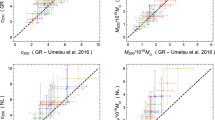Abstract
The theoretical framework of cosmology is mainly defined by gravity, of which general relativity is the current model. Recent tests of general relativity within the Lambda Cold Dark Matter (ΛCDM) model have found a concordance between predictions and the observations of the growth rate and clustering of the cosmic web1,2. General relativity has not hitherto been tested on cosmological scales independently of the assumptions of the ΛCDM model. Here we report an observation of the gravitational redshift of light coming from galaxies in clusters at the 99 per cent confidence level, based on archival data3. Our measurement agrees with the predictions of general relativity and its modification created to explain cosmic acceleration without the need for dark energy (the f(R) theory4), but is inconsistent with alternative models designed to avoid the presence of dark matter5,6.



Similar content being viewed by others
References
Rapetti, D. et al. The observed growth of massive galaxy clusters—III. Testing general relativity on cosmological scales. Mon. Not. R. Astron. Soc. 406, 1796–1804 (2010)
Reyes, R. et al. Confirmation of general relativity on large scales from weak lensing and galaxy velocities. Nature 464, 256–258 (2010)
Abazajian, K. N. et al. The Seventh Data Release of the Sloan Digital Sky Survey. Astrophys. J. Suppl. Ser. 182, 543–558 (2009)
Carroll, S. et al. Is cosmic speed-up due to new gravitational physics? Phys. Rev. D 70, 043528 (2004)
Milgrom, M. A modification of the Newtonian dynamics—implications for galaxies. Astrophys. J. 270, 371–389 (1983)
Bekenstein, J. D. Relativistic gravitation theory for the modified Newtonian dynamics paradigm. Phys. Rev. D 70, 083509 (2004)
Einstein, A. Die Grundlage der allgemeinen Relativitätstheorie. Astron. Nachr. 354, 769–822 (1916)
Cappi, A. Gravitational redshift in galaxy clusters. Astron. Astrophys. 301, 6–10 (1995)
Broadhurst, T. & Scannapieco, E. Detecting the gravitational redshift of cluster gas. Astrophys. J. 533, L93–L97 (2000)
Kim, Y.-R. & Croft, R. A. C. Gravitational redshifts in simulated galaxy clusters. Astrophys. J. 607, 164–174 (2004)
Hao, J. et al. A GMBCG galaxy cluster catalog of 55,424 rich clusters from SDSS DR7. Astrophys. J. Suppl. Ser. 191, 254–274 (2010)
Wojtak, R. et al. Interloper treatment in dynamical modelling of galaxy clusters. Astron. Astrophys. 466, 437–449 (2007)
Skibba, R. A. et al. Are brightest halo galaxies central galaxies? Mon. Not. R. Astron. Soc. 410, 417–431 (2011)
Pointecouteau, E. & Silk, J. New constraints on modified Newtonian dynamics from galaxy clusters. Mon. Not. R. Astron. Soc. 364, 654–658 (2005)
Schmidt, F. Dynamical masses in modified gravity. Phys. Rev. D 81, 103002 (2010)
Pound, R. V. & Rebka, G. A. Gravitational redshift in nuclear resonance. Phys. Rev. Lett. 3, 439–441 (1959)
Pound, R. V. & Snider, J. L. Effect of gravity on nuclear resonance. Phys. Rev. Lett. 13, 539–540 (1964)
Lopresto, J. C., Schrader, C. & Pierce, A. K. Solar gravitational redshift from the infrared oxygen triplet. Astrophys. J. 376, 757–760 (1991)
Greenstein, J. L., Oke, J. B. & Shipman, H. L. Effective temperature, radius, and gravitational redshift of Sirius B. Astrophys. J. 169, 563–566 (1971)
Barstow, M. A. et al. Hubble Space Telescope spectroscopy of the Balmer lines in Sirius B. Mon. Not. R. Astron. Soc. 362, 1134–1142 (2005)
Vessot, R. F. C. et al. Test of relativistic gravitation with a space-borne hydrogen maser. Phys. Rev. Lett. 45, 2081–2084 (1980)
Acknowledgements
The Dark Cosmology Centre is funded by the Danish National Research Foundation. R.W. wishes to thank D. Rapetti, G. Mamon and S. Gottlöber for discussions and suggestions. The mock catalogues of galaxy clusters have been obtained from a simulation performed at the Altix of the LRZ Garching.
Author information
Authors and Affiliations
Contributions
R.W. was responsible for the analysis of the velocity distributions and the velocity dispersion profile, predictions for the models of modified gravity, and drafting the manuscript. S.H.H. was responsible for the comparison with the constraints on gravitational redshift on different scales, and writing and commenting on the paper. J.H. conceived the idea of the measurement, and wrote and commented on the paper.
Corresponding author
Ethics declarations
Competing interests
The authors declare no competing financial interests.
Supplementary information
Supplementary Information
This file contains Supplementary Methods and Data, additional references and Supplementary Figures 1-4 with legends. (PDF 966 kb)
Rights and permissions
About this article
Cite this article
Wojtak, R., Hansen, S. & Hjorth, J. Gravitational redshift of galaxies in clusters as predicted by general relativity. Nature 477, 567–569 (2011). https://doi.org/10.1038/nature10445
Received:
Accepted:
Published:
Issue Date:
DOI: https://doi.org/10.1038/nature10445
- Springer Nature Limited
This article is cited by
-
Gravity tested on large scales
Nature (2011)
-
Shift happens
Nature Physics (2011)





